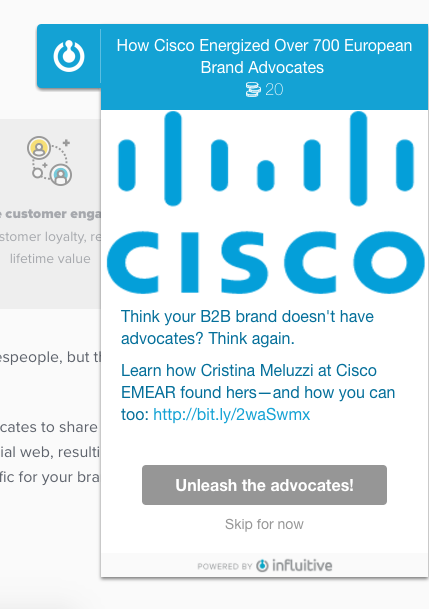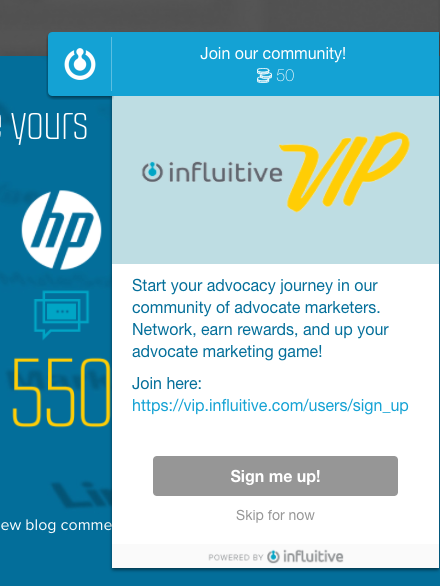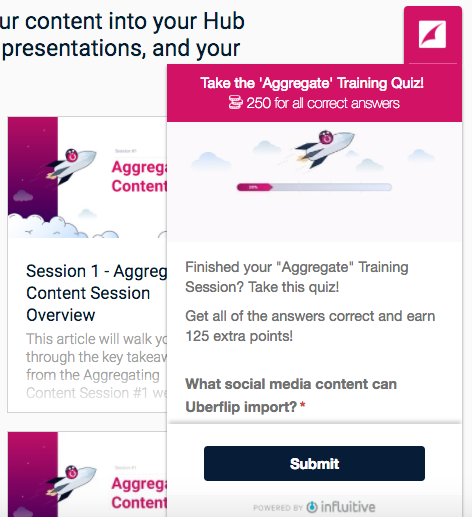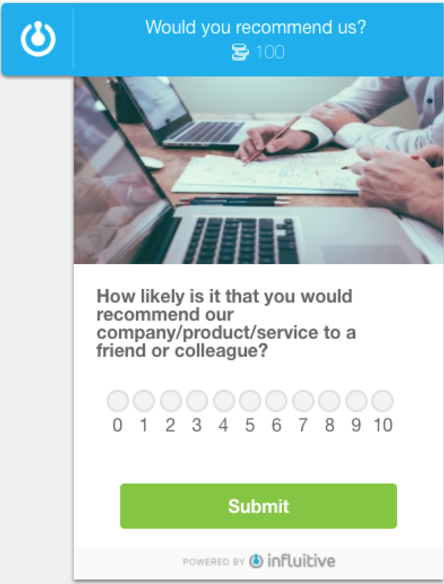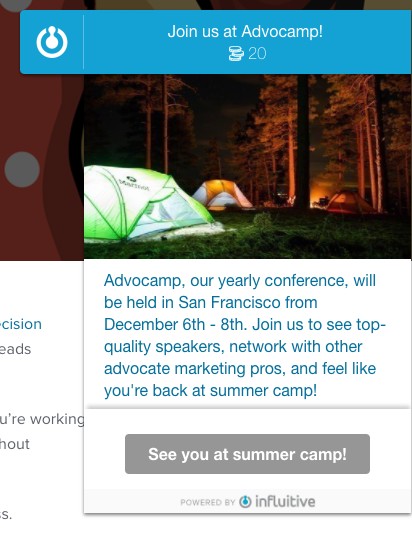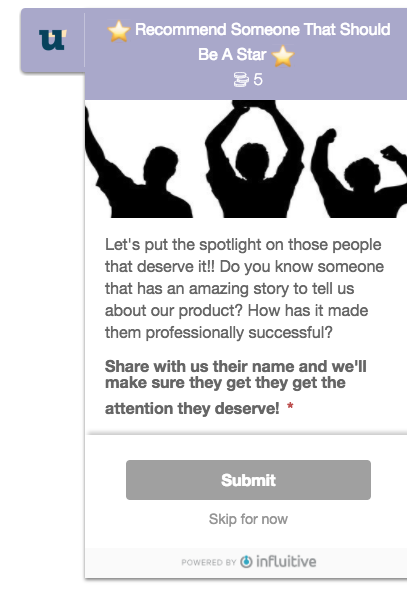Think about the last time you had an unexpectedly positive experience with a company or product. (Maybe your barista threw in a free biscotti with your morning americano?)
What did that experience make you want to do?
You likely wanted to tell others about it, or (at the very least) send the company a congratulatory note.
That experience was unexpectedly joyful! Faith in humanity = restored!
You probably didn’t take the time to find a ‘Contact Us’ form buried on their website… but you might have shared it on your personal social media accounts and tagged the company.
And maybe the company replied to your message with a “Thanks!”
But you and their social media manager probably let the interaction end there.
At least your mom liked your status update…
And therein lies the problem with great customer experiences today: the vast majority of companies don’t have ways to capture moments of delight, nor do they have processes for capitalizing on these moments to turn happy customers into valuable brand advocates.
Turning “moments of delight” into life-long brand advocacy
Imagine what could have happened if that company had asked their newly uncovered advocate to:
- Become a social media ambassador
- Beta test their next product before launch
- Refer a friend for a discount on their next purchase
If they had, the company could have turned a one-time interaction into a life-long relationship, inspiring the customer to do two things:
- Make repeat purchases, or be upsold
- Spread positive word-of-mouth about the company via online reviews, testimonials, referrals, and more
This missed opportunity is the reason we developed AdvocateAnywhere—an embeddable advocacy widget that allows you to uncover potential brand advocates, collect real-time feedback, and increase engagement when and where “moments of delight” happen, like your website, online community, or within your product.
(Want to see it in action? Just click on the blue icon on the upper right hand side of this screen!)
In this blog, we’re going to quickly cover how to turn a moment of customer delight into a lifelong advocate relationship.
Then we’ll dive into 16 points in the customer journey where you can apply this technique to uncover new advocates, build deeper relationships with them, and inspire them to advocate on your behalf.
Note: you don’t necessarily need our solution to use these ideas in your customer journey 😉
The process of inspiring brand advocates
Discovering and creating brand advocates is simple.
Step 1. Make a small ask of a customer, and see how they respond.
Step 2. If they say yes, recognize them for their participation. This means thanking them, or showing them appreciation in some small way.
Step 3. Repeat, but with a slightly bigger or more complex request. You’ll also have to increase the amount of appreciation you show them.
Following this process will inspire previously undiscovered advocates to be more engaged with your products and services (read: long-term retention), and be willing to take on bigger advocacy requests—such as press interviews, being in a case study, or referring their peers to your products.
We’ve built this ask-recognize-repeat process into AdvocateAnywhere. It has several functions that can be customized for tons of different purposes, from asking for feedback, collecting NPS, or requesting social shares.
Once advocates complete an activity, they’re offered points—a.k.a. instant recognition.
They can keep these points and accumulate more if they sign up to become an official advocate. The more activities they complete, the more points they earn.
Once they’ve joined, you can use this data to see who your biggest advocates are. Then, you can engage them on a deeper level based on their amount of participation.
Now, let’s talk about the touchpoints in the customer journey where you can find and build brand advocates!
I. Discovering potential brand advocates at the start of the customer journey
Here’s a few ways you can suss out potential advocates, and invite them into your advocate community.
1. Offer a promotion
If someone is scrolling on a product page (or in a feature within your product they don’t have access to), offer them a discount or special offer if they sign up for a demo to learn more.
Not only could this help you identify a potential prospect, but you’ve also discovered which customers may be looking at other products. (Hello potential upsells and/or new advocates!)
2. Offer related content
A new visitor to your blog, website or community might love to see more content similar to the page they’re on. Someone in your product may want to see your latest blog post on a new feature or use-case. And a prospect or customer in your community may want to see a relevant product page or knowledge base article if they’re browsing a particular section of your forum.
Pro tip: make the content be a tip or message from one of your current customers! Customers love to feel like they’re connecting with peers.
Offering a link to related content can enhance their experience—as long as it’s relevant. It also allows you to highlight new content you want customers, prospects or potential advocates to see first.
You can position it as access to *exclusive* content to entice users and make them feel special (which is one of the key tenets of building advocates).
3. Ask for content feedback
Test how effective your product copy, blogs or other resources are by asking for general feedback.
This could be as simple as “Was this what you were expecting/looking for?” or “Was this helpful?” using multiple choice answers.
You could also ask for more qualitative feedback on the piece, such as if it’s missing any information readers may like, or if users have a request for similar content.
Anyone who completes this types of request is an awesome potential advocate.
4. Ask them to join your advocate community
Placing an offer to join your advocate community is the easiest way to identify your biggest brand fans.
Position it as a chance to connect with your brand and get exclusive access to professional perks or resources, and you should see high join rates.
More important than the message is where you place it. Think about places potential advocates may be.
Here’s a few suggestions:
- Your online community
- On your blog subscriber ‘Thank You’ page
- After customers complete an NPS survey
- The confirmation page for an event or webinar registration page
- When someone completes an online training course
II. Engaging potential advocates once you’ve identified them
Once you’ve found your potential advocates, it’s time to build a relationship with them.
Here’s a few ways to increase engagement and show new advocates value in the early-to-mid stages of working with your products. It also sets them up to become active brand advocates later.
Pro tip: It’s important to place your requests in areas where you think your power users may hang out—like forums, certain sections of your website or knowledge base, your online community, or event registration sign-up pages.
5. Provide educational tips or quizzes
Share tips—like “Did You Know?” feature callouts—in areas where they would be helpful to users, such as knowledge base articles, related community threads, or within your application.
This gives your users a chance to gain more in-depth knowledge of your product and become more successful. Advocates love to increase their skills and gain mastery, so highlighting little known features or advanced hacks will make your product stickier to them.
You can also quiz users on the education you’re providing, and offer them a reward for completing it.
6. Ask them something about themselves
Asking advocates questions like “What’s your favourite thing about your role?” or “What’s your favourite coffee order?” helps build relationships with them.
The key is using this data later to give them more personalized requests or content… or surprise them with their favourite coffee order the next time you interact with them in real life.
Other things to consider asking about are the products they use, industry or vertical they work in, and when their birthday is.
7. Ask for product feedback
Advocates love to feel heard. So, ask them open ended or multiple-choice questions about features in your product. (This is one of those small “test the waters”-style advocacy asks we talked about earlier.)
Most companies ask for feedback via email surveys. But asking for it in specific sections of your product or website—when the visitor is actually engaged—is more much powerful.
Consider placing these types of requests in the related sections of your product, or on similar product pages or articles.
You may uncover some positive feedback you could turn into testimonials. (And make sure you share all this great feedback with your product team!)
You also don’t have to keep your feedback strictly related to your product. You could ask for feedback on content or a marketing campaign, or an experience on your website. Which brings us to our next point…
8. Ask for an NPS score
You can ask for an NPS score at different points in the customer journey, like after a support interaction or an online training course. You can also place it within your application to ask about their NPS for specific features.
The higher the score, the more likely this person is to take on bigger asks for you later.
For low scorers, think about how you can improve their experience. A good way to do this is by asking for more feedback to get to the root cause of the issue (see point 6).
Pro tip: One of our customers created a whole experience for their passive NPS customers. Learn how they turned 25% of passives into promoters with a formal advocacy program here.
9. Invite them to a user group or event
Advocates love opportunities to share their knowledge, connect with their peers and get closer to your company.
By placing exclusive invites to speak at a user group or event in specific parts of your community, product, or a related blog article, you can identify potential power advocates. If you offer them a discount, VIP seating, or a similar exclusive perk for becoming an advocate, they’ll be more likely to participate.
In either instance, consider also asking them to not only register, but also to share topic ideas they’d like to learn about. You may even source a customer speaker this way. (Pro tip: share their responses with your content team. Their suggestions will likely make useful blogs or other resources!)
You could also ask them for their location, or where they’d like the next user group to be, to help with your events strategy.
10. Offer sneak peeks or beta testing for new products or features
Get your advocates excited about your latest feature or product iteration by sharing a preview within your community, or even within your product itself. You could also ask them to register to beta test your next product.
The exclusivity and behind-the-scenes access is exciting to advocates, and almost a reward in and of itself.
You can also do this with messaging, marketing campaigns, a new website design—anything you would normally want to create focus groups for.
11. Identify Customer Advisory Board (CAB) members
Identify and engage potential CAB members by offering power users an invite to join your next meetup or a private community.
This could come after they’ve given you product feedback, registered for an event, or any of the other examples we listed above.
To determine whether your potential CAB members are right for your board, you could ask them follow-up questions about their product usage or knowledge, and for their title.















































